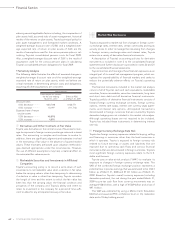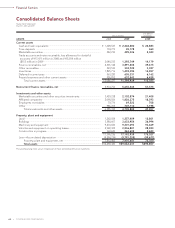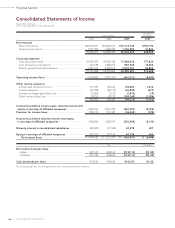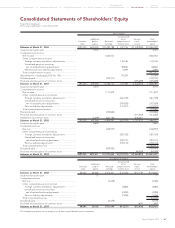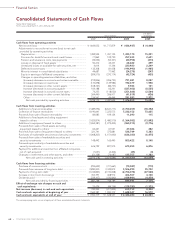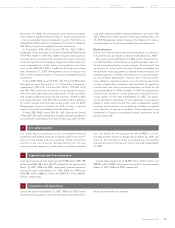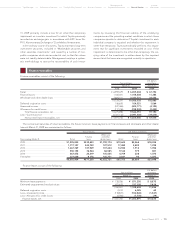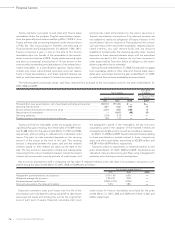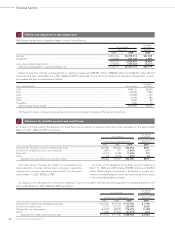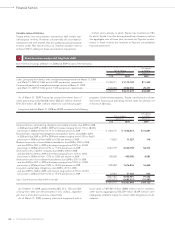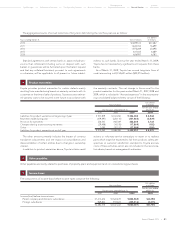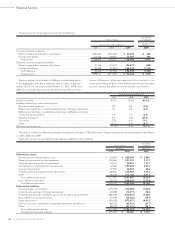Toyota 2009 Annual Report Download - page 74
Download and view the complete annual report
Please find page 74 of the 2009 Toyota annual report below. You can navigate through the pages in the report by either clicking on the pages listed below, or by using the keyword search tool below to find specific information within the annual report.
Financial Section
TOYOTA MOTOR CORPORATION
72
Net income per share
Basic net income per common share is calculated by dividing
net income by the weighted-average number of shares out-
standing during the reported period. The calculation of diluted
net income per common share is similar to the calculation of
basic net income per share, except that the weighted-average
number of shares outstanding includes the additional dilution
from the assumed exercise of dilutive stock options.
Stock-based compensation
Toyota measures compensation expense for its stock-based
compensation plan based on the grant-date fair value of the
award, and accounts for the award in accordance with FAS No.
123(R), Share—Based Payment (revised 2004).
Other comprehensive income
Other comprehensive income refers to revenues, expenses,
gains and losses that, under accounting principles generally
accepted in the United States of America are included in com-
prehensive income, but are excluded from net income as these
amounts are recorded directly as an adjustment to shareholders’
equity. Toyota’s other comprehensive income is primarily com-
prised of unrealized gains/losses on marketable securities des-
ignated as available-for-sale, foreign currency translation
adjustments and adjustments attributed to pension liabilities or
minimum pension liabilities associated with Toyota’s defined
benefit pension plans.
Accounting changes
In June 2006, the Financial Accounting Standards Board
(“FASB”) issued FASB Interpretation No. 48, Accounting for
Uncertainty in Income Taxes—an interpretation of FASB
Statement No. 109 (“FIN 48”). FIN 48 clarifies the accounting for
uncertainty in tax positions and requires a company to recog-
nize in its financial statements, the impact of a tax position, if
that position is more likely than not to be sustained on audit,
based on the technical merits of the position. Toyota adopted
FIN 48 from the fiscal year begun after December 15, 2006. See
note 16 to the consolidated financial statements for the impact
of the adoption of the interpretation on Toyota’s consolidated
financial statements.
In September 2006, FASB issued FAS No. 157, Fair Value
Measurements (“FAS 157”), which defines fair value, establishes
a framework for measuring fair value and expands disclosures
about fair value measurements. Toyota adopted FAS 157 from
the fiscal year begun after November 15, 2007. Toyota adopted
FASB Staff Position (“FSP”) No. FAS 157-2, Effective Date of
FASB Statement No. 157, which defers the effective date of FAS
157 for certain nonfinancial assets and nonfinancial liabilities to
fiscal year beginning after November 15, 2008, and interim peri-
od within the fiscal year. The adoption of FAS 157 did not have a
material impact on Toyota’s consolidated financial statements.
See note 26 to the consolidated financial statements for disclo-
sures of the adoption of these statements.
In September 2006, FASB issued FAS 158. FAS 158 requires
employers to measure the funded status of their defined benefit
postretirement plans as of the date of their year-end statement
of financial position. Toyota adopted the provision in FAS 158
regarding a measurement date from the fiscal year ended after
December 15, 2008. The adoption of this provision in FAS 158
did not have a material impact on Toyota’s consolidated finan-
cial statements.
In February 2007, FASB issued FAS No. 159, The Fair Value
Option for Financial Assets and Financial Liabilities—Including
an amendment of FASB Statement No. 115 (“FAS 159”). FAS
159 permits entities to measure many financial instruments and
certain other assets and liabilities at fair value on an instrument-
by-instrument basis and subsequent change in fair value must
be recorded in earnings at each reporting date. Toyota adopted
FAS 159 from the fiscal year begun after November 15, 2007.
The adoption of FAS 159 did not have a material impact on
Toyota’s consolidated financial statements.
In March 2008, FASB issued FAS No. 161, Disclosures about
Derivative Instruments and Hedging Activities—an amendment
of FASB Statement No. 133 (“FAS 161”). FAS 161 changes and
enhances the current disclosure requirements for derivative
instruments and hedging activities under FAS No. 133,
Accounting for Derivative Instruments and Hedging Activities.
Toyota adopted FAS 161 from the fiscal year ended March 31,
2009. The adoption of FAS 161 did not have a material impact
on Toyota’s consolidated financial statements. See note 20 to
the consolidated financial statements for disclosures of the
adoption of the statement.
Recent pronouncements to be adopted
in future periods
In December 2007, FASB issued FAS No. 141(R), Business
Combinations (“FAS 141(R)”). FAS 141(R) establishes principles
and requirements for how the acquirer recognizes and measures
the identifiable assets acquired, the liabilities assumed, any non-
controlling interest, and the goodwill acquired in a business
combination or a gain from a bargain purchase. Also, FAS 141(R)
provides several new disclosure requirements that enable users
of the financial statements to evaluate the nature and financial
effects of the business combination. FAS 141(R) is effective to
business combinations on and after the beginning of fiscal year
beginning on or after December 15, 2008. The impact of adopt-
ing FAS 141(R) on Toyota’s consolidated financial statements will
depend on the nature and significance of any acquisitions in the
future period.
In December 2007, FASB issued FAS No. 160, Noncontrolling
Interests in Consolidated Financial Statements—an amendment
of ARB No. 51 (“FAS 160”). FAS 160 amends the guidance in
Accounting Research Bulletins No. 51, Consolidated Financial
Statements, to establish accounting and reporting standards for
the noncontrolling interest in a subsidiary and for the deconsoli-
dation of a subsidiary. FAS 160 is effective for fiscal year, and
interim period within the fiscal year, beginning on or after


